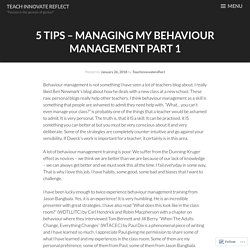

Sir! I know this! Sir! Sir! The scene is familiar.

The student, frankly hopping out of their seat, arm stretched aloft and flapping like a leaf caught in a cobweb during a coastal storm. A tortured simile, but you probably get the point – it’s familiar, and a little annoying. Yes, Sammy, I know you know. You putting your hand up is the signal to me that communicates “Sir, I know this.” Please stop pestering me, I’m the one who decides who answers questions, and you’re making a scene. But I know the answer sir! Sigh. This case might only be mildly annoying, but there is a whole group of student behaviours within the category of “trying to participate but being infuriating with it” that might be annoying to start with, but can quickly turn into something worse than annoying. In the student’s head, they don’t think they’ve done anything wrong. PATHS® Childhood Development Programme for Schools. Some thoughts on education. Teacher-led disruption. Emotional literacy support assistants - ELSAs support children in schools. Network with other ELSAs and share free resources.
Free Printable Behavior Charts for Kids. How do i feel today2. Corridors. Stephen’s got ADHD.

He’s such a lovable child, but impulse control is not his strong point. His family have taught him that he must take revenge – physically of course – if crossed. This isn’t the most school-friendly of combinations. Paul is in the same class. His dad is in prison for unspeakable things and his mum deals drugs for a local criminal overload. The school works hard to meet the needs of these children. Transitions between class and play, or PE, or music or assembly – these are hard.
Everybody knows that the corridor is the once place you might get away with an insult or crafty push. Daniel is autistic. These are unpleasant for everyone. Yet this was all so avoidable. When the school introduced silent corridors, these stress-ridden, hyper-vigilant children could relax. The adults were in charge again. In a different school where not quite as many children had such stressful lives, Susie might have enjoyed strolling in from play, chatting to her friends.
Like this: Managing my behaviour management part 2 – Teach innovate reflect. Follow @p4ssionform4ths project for progress and news on our maths year 5-8 transition development and upskilling of maths teachers and leaders.

This is the second of two blogs on how I manage behaviour: Part 1: 3 agreed rules, SLANT, Golden iPhone, micro-scripting, show call. Part 2: Key routines, Lateness, Low level disruption, “Picking up your own tab” I repeat an important point from my first post that behaviour management is a skill. It’s a skill that can be improved. Key routines Teachers often refer to routines as starts and ends to lessons but it is much more than that. Things to think about: How long does a class actually need to pack away at the end? Routines take time to become routines! 5 tips – Managing my behaviour management part 1 – Teach innovate reflect. Behaviour management is not something I have seen a lot of teachers blog about.

I really liked Ben Newmark’s blog about how he deals with a new class at a new school. These raw, personal blogs really help other teachers. Social influence social norms conformity and compliance 1998. Let's stop relying on hunches – it's time to use evidence to fix behaviour in schools. Many schools face a common challenge.

They want to improve – grades, critical thinking, whatever – but when designing strategies that make a difference they frequently overlook issues with behaviour. I’ve been in hundreds of schools, and noticed that when behaviour is poor every other outcome suffers. When behaviour is better, children’s (and staff’s) lives and learning get better too. When you actually ask the teachers, they seem to report behaviour as being worse than official reports suggest.
This has certainly been my experience from over a decade working and training in schools. A lot of what passes for advice in this area is what I call “folk” teaching. The ability to create a calm, safe space for learning is crucial to learning outcomes for children. Thankfully we now know a good deal about human behaviour, and we can draw on a number of sources to help us understand crucial factors such as motivation, engagement, learning and behaving. Bandura2005. School's success possible because of young staff, says head. The 'Preset': How Emily Badillo Wraps Simple What To Do's in a Loving Smile to Keep Her Lesson On the Rails. Some of the most important moments to manage when you are trying to build great culture are the moments when things are going well.

It’s important to reinforce positive behavior when you see it of course and when you have to make small re-directions to help students keep doing the right things the sooner you can do it, the more positively and non-invasively you can be. Behaviour Policy September 2014 docx updated Feb 2017.